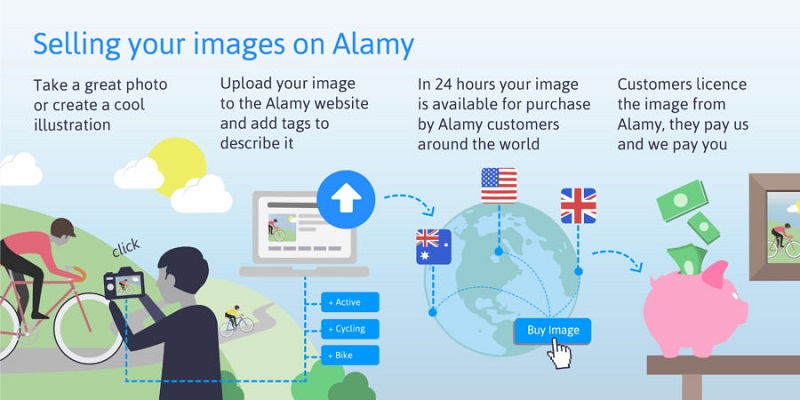1. Introduction
Also Read This: How to Obtain and Utilize YouTube Transcripts
2. Understanding Alamy and its Submission Guidelines

a) Image format and technical requirements
Alamy typically accepts JPEG files with a minimum resolution of 6 megapixels. Make sure your mobile device captures images in a suitable format and resolution to meet these requirements.b) Model and property releases
If your photo includes recognizable individuals or private property, you may need to obtain model or property releases. These releases grant permission for the commercial use of the images and protect both the subjects and Alamy from legal issues.c) Intellectual property rights and copyright considerations
It is crucial to ensure that the images you submit are your own original work and do not infringe upon any copyrights or trademarks. Alamy requires photographers to have the necessary rights to license and sell the images they submit.By understanding and adhering to Alamy's submission guidelines, you increase the likelihood of your mobile photos being accepted and made available for licensing.Also Read This: How to Lock an Image in PowerPoint
3. Mastering Mobile Photography for Alamy
a) Composition and framing
Pay attention to the composition of your image by utilizing the rule of thirds, leading lines, symmetry, or other compositional techniques. Experiment with different angles and perspectives to create visually interesting and engaging photographs.b) Lighting and exposure
Good lighting is crucial for capturing high-quality photos. Take advantage of natural light whenever possible and avoid harsh shadows. Use the exposure controls on your mobile device to adjust the brightness and ensure proper exposure in your images.c) Focus and sharpness
Tap on the subject you want to focus on within the frame to ensure it is sharp and well-defined. Avoid blurry images by holding your phone steady or using a tripod. Utilize the autofocus and manual focus features of your camera app for precise control.d) Post-processing techniques to enhance mobile photos
Explore various photo editing apps and tools to enhance your mobile photos. Adjust the brightness, contrast, and saturation to optimize the overall look of the image. Remove imperfections, noise, or distractions using tools like spot healing or cloning.By mastering these techniques, you can elevate the quality of your mobile photos and make them more appealing for Alamy submission. In the next section, we'll discuss how to assess image quality to meet Alamy's requirements.Also Read This: How to Shoot Photos for Getty Images and Get Noticed
4. Assessing Image Quality for Alamy Submission
a) Pixel count, resolution, and file size requirements
Alamy generally requires a minimum resolution of 6 megapixels for images. Check the specifications of your mobile device's camera and adjust the settings accordingly to meet this requirement. Additionally, be mindful of file size limitations to ensure efficient uploading and downloading.b) Evaluating image sharpness and detail
Zoom in on your photos to examine the sharpness and detail. Ensure that important elements in the image are well-defined and free from blur or pixelation. Images should be crisp and in focus, with clear edges and fine details.c) Considerations for noise and grain
Pay attention to the level of noise or grain in your photos, especially in low-light conditions or high ISO settings. Excessive noise can degrade the overall quality of the image. Use noise reduction techniques during post-processing to minimize noise without sacrificing too much detail.d) Color accuracy and white balance considerations
Colors should appear accurate and vibrant in your photos. Check for any color casts or inaccurate white balance that might affect the overall visual appeal. Adjust the white balance during editing to ensure natural and pleasing colors.e) Ensuring commercial viability and market relevance
Assess the commercial potential and market relevance of your images. Consider the subject matter, concept, and overall appeal to potential buyers. Images that fulfill current market trends and demands are more likely to be selected for licensing.By thoroughly assessing these quality considerations, you can ensure that your mobile photos meet the requirements and stand out in the competitive world of stock photography. In the next section, we'll explore the legal and ethical considerations associated with Alamy submissions.Also Read This: Sizing Images for Sublimation Tumblers: A Quick Guide
5. Legal and Ethical Considerations
a) Model and property releases
If your photo includes recognizable individuals or private property, you may need to obtain model or property releases. These releases grant permission for the commercial use of the images and protect both the subjects and Alamy from any legal issues. Ensure that you have appropriate releases for all relevant images.b) Avoiding trademarked or copyrighted content
Ensure that your photos do not contain any copyrighted or trademarked material, such as logos, brand names, or copyrighted artwork. Using such content without permission can lead to copyright infringement or violation of intellectual property rights.c) Ethical implications of photo manipulation and editing
While editing and post-processing can enhance the visual appeal of your images, be mindful of the ethical implications. Avoid excessive manipulation that alters the reality of the scene or misrepresents the subject matter. Maintain the integrity of the image while enhancing its quality.It's important to conduct thorough research and familiarize yourself with the legal requirements and ethical guidelines associated with photography and image usage. By adhering to these considerations, you ensure that your submissions to Alamy are both legally compliant and ethically responsible.Also Read This: Blurring Text in an Image Using Paint
6. Tips for a Successful Submission on Alamy
a) Read the Guidelines
Start by thoroughly reading and understanding Alamy's submission guidelines. Familiarize yourself with their specific requirements regarding image quality, resolution, format, and any other technical specifications. Adhering to these guidelines is essential for a smooth submission process.b) Choose Relevant and Marketable Images
Select photos that have commercial appeal and fit within popular stock photography categories. Consider what buyers are looking for, such as lifestyle, travel, nature, business, or concepts. Research current trends in stock photography and try to capture images that align with market demands.c) Focus on Image Quality
Ensure your photos are of high quality and technically sound. Pay attention to factors like focus, exposure, composition, and noise reduction. Avoid submitting images that are blurry, underexposed, or suffer from technical issues that may diminish their commercial value.d) Keywording and Metadata
Accurate and comprehensive keywording is crucial for increasing the discoverability of your images. Choose relevant and specific keywords that accurately describe the subject matter, concept, and potential usage of the photo. Include information like location, people, objects, emotions, and other relevant details. Additionally, provide accurate and descriptive metadata for each image.e) Model and Property Releases
If your photos include recognizable individuals or private property, ensure that you have obtained the necessary model and property releases. This is particularly important for commercial usage. Alamy requires valid releases for certain types of images, so make sure you have the appropriate documentation when needed.f) Diversity and Inclusivity
Stock photography buyers are increasingly looking for diverse and inclusive images that represent a wide range of demographics and cultures. Include a variety of subjects, models, and locations to cater to this demand and broaden the appeal of your portfolio.g) Avoid Overediting
While basic enhancements and corrections are acceptable, excessive editing and manipulation can be detrimental to your submission. Alamy generally prefers authentic and natural-looking photos. Maintain the integrity and authenticity of your images by avoiding heavy filters, extreme retouching, and unrealistic alterations.h) Be Persistent and Consistent
Building a successful portfolio takes time and effort. Be consistent in your submissions, continuously improving your skills, and learning from feedback or rejections. Keep uploading new content regularly to increase your chances of attracting buyers and generating sales.i) Review and Learn
Take the time to review your submitted images and analyze feedback, whether it's from Alamy or from the stock photography community. Learn from any rejections and understand the reasons behind them. Use this knowledge to improve your future submissions and increase your acceptance rate.By following these tips, you can enhance your chances of a successful submission on Alamy and increase the visibility and marketability of your mobile photos in the stock photography industry.@alamy tips on improving workflow speed during submission when at live events (like sporting ones)
— Feroz Khan (@zoomnclick) September 3, 2015
Also Read This: Educational and Fun Content on Dailymotion Through Stories and Tutorials
7. Troubleshooting Common Challenges
In this section, we will explore some of the common challenges that mobile photographers face when submitting their photos to Alamy. We will discuss various issues that may arise and provide practical solutions and tips to overcome them.a) Addressing issues with noise, blur, and exposure in mobile photos:
- Understanding the limitations of mobile camera sensors and how they can affect image quality.
- Techniques for reducing noise in low-light conditions, such as using image stabilization or external lighting.
- Tips for avoiding blurry photos, including holding the phone steady, using burst mode, or using a tripod.
- Adjusting exposure settings to ensure well-balanced and properly exposed photos.
b) Handling complex or ambiguous copyright situations:
- Educating oneself about copyright laws and regulations to understand the rights and limitations of photographing certain subjects.
- Seeking legal advice or consulting with copyright experts when encountering complex copyright scenarios.
- Obtaining appropriate permissions and releases when photographing copyrighted material or recognizable individuals.
- Keeping thorough records of permissions obtained and documenting the source of inspiration or references used in the photo.
c) Dealing with rejection and learning from feedback:
- Understanding that rejection is a normal part of the submission process and not taking it personally.
- Reading and analyzing feedback provided by Alamy reviewers to identify areas for improvement.
- Incorporating constructive criticism into future photography sessions to enhance skills and image quality.
- Seeking guidance from experienced photographers or joining photography communities to receive valuable input and support.
d) Strategies for continuous improvement and staying ahead in the mobile photography market:
- Staying updated with the latest trends, techniques, and equipment in mobile photography.
- Engaging in regular practice and experimentation to refine skills and develop a unique photographic style.
- Participating in workshops, courses, or online tutorials to learn new editing techniques or gain insights from professionals.
- Analyzing successful mobile photographers on Alamy and other platforms to identify strategies and elements that make their work stand out.

 admin
admin








